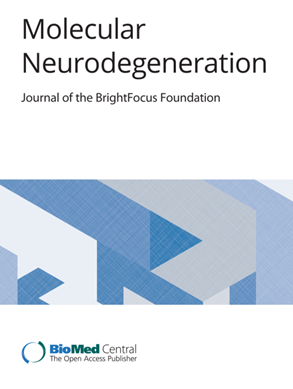NEK1突变引起纤毛功能障碍是肌萎缩性侧索硬化症的一种新的致病机制
IF 17.5
1区 医学
Q1 NEUROSCIENCES
引用次数: 0
摘要
神经元初级纤毛对信号传导和细胞周期调节至关重要,与维持神经元身份有关。虽然原发性纤毛缺陷和神经退行性疾病之间的联系正在出现,但确切的病理机制仍不清楚。我们通过分析920名韩国ALS患者的外显子组序列,研究了NEK1在ALS发病中的遗传贡献。为了了解NEK1变异在ALS中的疾病贡献,我们使用患者成纤维细胞进行了一系列功能研究,重点关注初级纤毛和微管相关表型。此外,这些发现在ipsc衍生的运动神经元(iPSC-MNs)中得到了验证。nima相关激酶1 (NEK1)是一种编码丝氨酸/苏氨酸激酶参与细胞周期调控的基因,已被确定为肌萎缩性侧索硬化症(ALS)的危险基因。在这里,我们报道了NEK1突变导致ALS的原发性纤毛异常、细胞周期再进入和微管蛋白乙酰化中断。我们分析了920名韩国散发性ALS患者的全外显子组序列,并在23名患者中鉴定出16种NEK1变异。我们发现了两个新的变异,p.E853Rfs*9和p.M1?NEK1表达减少,导致功能缺失(LOF),一个同义剪接变体(p.Q132=)表现出缺乏外显子5的异常异构体。所有三种NEK1变异都表现出异常的初级纤毛结构、受损的超音刺猬信号和改变的细胞周期进程。此外,als相关变异诱导细胞内钙超载,随后极光激酶A (AurA)-组蛋白去乙酰化酶(HDAC)6激活,导致纤毛脱落。这些缺陷可以通过细胞内Ca2+螯合剂BAPTA修复。我们还发现NEK1变异导致α-微管蛋白乙酰化降低、线粒体改变和DNA损伤反应(DDR)受损。值得注意的是,抑制HDAC6的药物治疗恢复了患者成纤维细胞中nek1依赖性的缺陷。并且,我们证实在患者成纤维细胞中发现的数据可以在iPSC-MNs模型中复制。我们的研究结果表明,NEK1通过LOF机制参与了ALS的发病机制,抑制HDAC6为NEK1变异相关的ALS治疗提供了一种有吸引力的治疗策略。本文章由计算机程序翻译,如有差异,请以英文原文为准。
Mutations in NEK1 cause ciliary dysfunction as a novel pathogenic mechanism in amyotrophic lateral sclerosis
Neuronal primary cilia, vital for signaling and cell-cycle regulation, have been implicated in maintaining neuronal identity. While a link between primary ciliary defects and neurodegenerative diseases is emerging, the precise pathological mechanisms remain unclear. We studied the genetic contribution of NEK1 to ALS pathogenesis by analyzing the exome sequences of 920 Korean patients with ALS. To understand the disease contribution of NEK1 variants in ALS, we performed a series of functional studies using patient fibroblasts focusing on primary cilia and microtubule-related phenotypes. In addition, these findings were validated in iPSC-derived motor neurons (iPSC-MNs). NIMA-related kinase 1 (NEK1), a gene encoding a serine/threonine kinase involved in cell cycle regulation, has been identified as a risk gene for amyotrophic lateral sclerosis (ALS). Here, we report that mutations in NEK1 cause primary ciliary abnormality, cell cycle re-entry, and disrupted tubulin acetylation in ALS. We analyzed the whole-exome sequences of 920 Korean patients with sporadic ALS and identified 16 NEK1 variants in 23 patients. We found that two novel variants, p.E853Rfs*9 and p.M1?, reduced NEK1 expression, resulting in loss-of-function (LOF) and one synonymous splicing variant (p.Q132=) exhibited an aberrant isoform lacking exon 5. All three NEK1 variants exhibited abnormal primary ciliary structure, impaired sonic hedgehog signaling, and altered cell-cycle progression. Furthermore, the ALS-linked variants induced intracellular calcium overload followed by Aurora kinase A (AurA)-histone deacetylase (HDAC)6 activation, resulting in ciliary disassembly. These defects were restored by treatment with the intracellular Ca2+ chelator, BAPTA. We also found that NEK1 variants cause decreased α-tubulin acetylation, mitochondrial alteration, and impaired DNA damage response (DDR). Notably, drug treatment to inhibit HDAC6 restored the NEK1-dependent deficits in patient fibroblasts. And, we confirmed that data found in patient fibroblasts were reproduced in iPSC-MNs model. Our results suggest that NEK1 contributes to ALS pathogenesis through the LOF mechanism, and HDAC6 inhibition provides an attractive therapeutic strategy for NEK1 variants associated ALS treatment.
求助全文
通过发布文献求助,成功后即可免费获取论文全文。
去求助
来源期刊

Molecular Neurodegeneration
医学-神经科学
CiteScore
23.00
自引率
4.60%
发文量
78
审稿时长
6-12 weeks
期刊介绍:
Molecular Neurodegeneration, an open-access, peer-reviewed journal, comprehensively covers neurodegeneration research at the molecular and cellular levels.
Neurodegenerative diseases, such as Alzheimer's, Parkinson's, Huntington's, and prion diseases, fall under its purview. These disorders, often linked to advanced aging and characterized by varying degrees of dementia, pose a significant public health concern with the growing aging population. Recent strides in understanding the molecular and cellular mechanisms of these neurodegenerative disorders offer valuable insights into their pathogenesis.
 求助内容:
求助内容: 应助结果提醒方式:
应助结果提醒方式:


